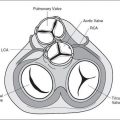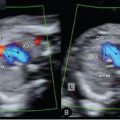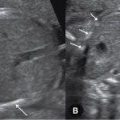HYPOPLASTIC LEFT HEART
SYNDROME
 AORTIC STENOSIS AND CRITICAL AORTIC STENOSIS
AORTIC STENOSIS AND CRITICAL AORTIC STENOSIS
Definition, Spectrum of Disease, and Incidence
Aortic stenosis is defined as narrowing at the level of the aortic valve leading to an obstruction of left ventricular outflow (Fig. 11-1). The stenosis is classified as valvular, subvalvular, or supravalvular according to the anatomic location of the obstruction in relation to the aortic valve. Valvular aortic stenosis is the most common type diagnosed prenatally; the other two are rarely encountered on prenatal ultrasound, especially in an isolated form.
In valvular aortic stenosis, the valve leaflets are dysplastic and are either tricuspid with fused commissures, bicuspid, unicuspid, or noncommissural. The spectrum of aortic stenosis varies from an isolated mild lesion, mild aortic stenosis (Fig. 11-1A), to a severe lesion, critical aortic stenosis, which may lead to a secondary dysfunction of the left ventricle, signs of endocardial fibroelastosis, and hypoplastic left heart syndrome (Fig. 11-1B). Figure 11-2 demonstrates an anatomic specimen of critical aortic stenosis with endocardial fibroelastosis, and Table 11-1 lists differentiating characteristics of mild and critical aortic stenosis.
Aortic stenosis occurs in 3% to 6% of structural heart defects and is more common in boys, with a ratio of 3:1 to 5:1 (1–3). Isolated mild aortic stenosis is rare in fetal series, whereas critical aortic stenosis is more common and easily detectable due to the abnormal four-chamber anatomy (4) (Figs. 11-1B and 11-2). Bicuspid aortic valve, which occurs in about 1% of the population and represents one of the most common congenital heart malformations, can be detected prenatally and is not associated with hemodynamic abnormalities in the absence of aortic stenosis (5).
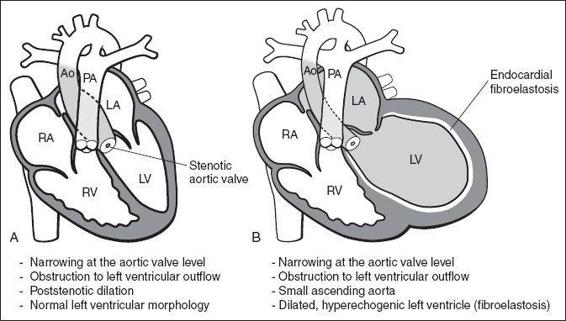
Figure 11-1. Aortic stenosis (A) and critical aortic stenosis (B). RV, right ventricle; LV, left ventricle; RA, right atrium; LA, left atrium; PA, pulmonary artery; Ao, aorta.
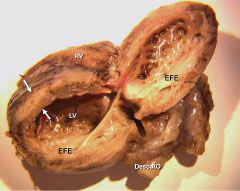
Figure 11-2. Anatomic specimen of a fetal heart with critical aortic stenosis. The lateral left ventricular (LV) wall is open, demonstrating the thickened and echogenic endocardium (arrows). Desc AO, descending aorta; RV, right ventricle; EFE, endocardial fibroelastosis.
Ultrasound Findings
Gray Scale (Mild Aortic Stenosis)
Mild aortic stenosis is difficult to detect prenatally due to a normal four-chamber anatomy in the majority of cases (Fig. 11-3). The typical left ventricular myocardial hypertrophy found postnatally is occasionally noted in late gestation. The five-chamber view may show a poststenotic dilation of the ascending aorta (Fig. 11-4). At the level of the aortic valve, thickened valve leaflets, doming of the cusps, and lack of complete valve opening during systole may be observed (Fig. 11-4). A cross section at the level of the aortic valve (short axis of right ventricle) may show the number of cusps and the presence of any thickening of the commissures (5) (Fig. 11-5).
Color Doppler (Mild Aortic Stenosis)
The detection of mild aortic stenosis is mainly achieved by the routine use of color Doppler with the detection of turbulent flow across the aortic valve (Fig. 11-6). Pulsed Doppler reveals high peak systolic velocities of greater than 200 cm/sec (Fig. 11-7). The three-vessel view on color Doppler shows a turbulent antegrade flow through a normal-size aortic arch (Fig. 11-8).
| TABLE 11-1 | Differentiating Characteristics of Mild and Critical Aortic Stenosis |
